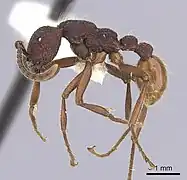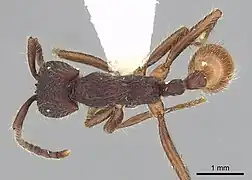Neivamyrmex sumichrasti
Neivamyrmex sumichrasti is a species of doryline army ant in the genus Neivamyrmex. It is found in Central America, from southern Mexico to Costa Rica.
| Neivamyrmex sumichrasti | |
|---|---|
 | |
| A Neivamyrmex sumichrasti specimen seen in profile | |
| Scientific classification | |
| Domain: | Eukaryota |
| Kingdom: | Animalia |
| Phylum: | Arthropoda |
| Class: | Insecta |
| Order: | Hymenoptera |
| Family: | Formicidae |
| Genus: | Neivamyrmex |
| Species: | N. sumichrasti |
| Binomial name | |
| Neivamyrmex sumichrasti (Norton, 1868b) | |
| Synonyms | |
|
Eciton sumichrasti Norton, 1868a | |
Name
The species was first named Eciton sumichrasti by Edward Norton in 1868, in commemoration of Swiss-Mexican naturalist François Sumichrast, who identified the species.[1] Identification with the genus Eciton is now obsolete, and it is recognized as belonging to the genus Neivamyrmex.[2]
Range
Neivamyrmex sumichrasti has a Central American distribution. It is found from southern Mexico south to Costa Rica. It specializes in Cloud Forest habitats. It is common in Monteverde, Costa Rica, occurring from 1300m on the Pacific side and as low as 900m on the Atlantic side.[3] In Mexico, it is found in Chiapas, San Luis Potosí, Veracruz, and Yucatán.[4]
Description
The head and mesosoma have multiple rounded depressions on them, and the overall colour can vary from black to dark reddish-brown.[4] The face, when viewed head on, shows triangular projections.[3] It is more coarsely punctated than other species in its genus,[5] with its face and dorsum granulopunctate.[6] It appears matte, not shining.[3] Raid columns resemble those of Simopelta, a genus of Ponerimorph ants, due to convergent evolution.[7]
Behaviour
Neivamyrmex sumichrasti, like other army ants, live in large colonies and forage through raiding. It raids both diurnally and nocturnally.[5] The raids most often take place above ground while its bivouac sites are presumably subterranean.[8] Its diet consists chiefly of ant larvae, and it does engage in cannibalism.[5]
Its large raid columns act as a host to other species. These include various staphylinids of the subtribe myrmedoniina. The staphylinids Ecitosius gracilis and Ecitosius robustus have evolved a similar colouration and punctation pattern as N. sumichrasti. These species are adapted to living in the army ant host. The staphylinid Ecitana biimpressa eat the larvae of N. sumichrasti, and can affect the amount of booty brought back through raids as well as the number of larvae that survive.[5]
Gallery
- Specimens
 A specimen seen from above.
A specimen seen from above. A specimen's head, seen from the front.
A specimen's head, seen from the front. A specimen seen in profile.
A specimen seen in profile.
References
- Norton, Edward (1868). "Remarks by Edward Norton. The species of Eciton forwarded by Prof. Sumichrast may be temporarily classified as follows". Transactions of the American Entomological Society. 2: 44–46.
- Bolton, Barry. "Neivamyrmex sumichrasti - AntCat". antcat.org. Retrieved 18 April 2023.
- Longino, John T. (2005). "Neivamyrmex sumichrasti (Norton 1868)". John T. Longino: Specializing in Neotropical Myrmecology. Retrieved 18 April 2023.
- Quiroz Robledo, Luis N.; Valenzuela González, Jorge (2014-03-18). "Las hormigas Ecitoninae (Hymenoptera: Formicidae) de Morelos, México". Revista de Biología Tropical (in Spanish). 54 (2): 531. doi:10.15517/rbt.v54i2.13918. ISSN 2215-2075.
- Akre, Roger D.; Rettenmeyer, Carl W. (1966). "Behavior of Staphylinidae Associated with Army Ants (Formicidae: Ecitonini)". Journal of the Kansas Entomological Society. 39 (4): 745–782. ISSN 0022-8567. JSTOR 25083583.
- Longino, John (2005-07-14). "Formicidae: Neivamyrmex sumichrasti". ants.biology.utah.edu. Retrieved 2023-07-17.
- Monteverde: Ecology and Conservation of a Tropical Cloud Forest. Nalini Nadkarni, Nathaniel T. Wheelwright. New York: Oxford University Press. 2000. p. 133. ISBN 978-0-19-977097-7. OCLC 777576758.
{{cite book}}: CS1 maint: others (link) - Bulova, S.; Purce, K.; Khodak, P.; Sulger, E.; O’Donnell, S. (2016). "Into the black and back: the ecology of brain investment in Neotropical army ants (Formicidae: Dorylinae)". The Science of Nature. 103 (3–4): 31. Bibcode:2016SciNa.103...31B. doi:10.1007/s00114-016-1353-4. ISSN 0028-1042. PMID 26956233. S2CID 253637085.